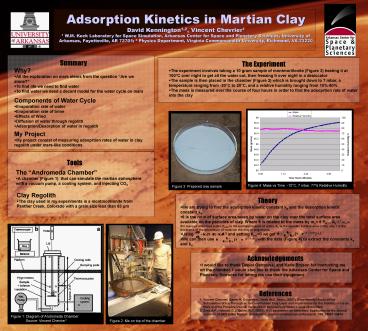The Experiment - PowerPoint PPT Presentation
Title:
The Experiment
Description:
Adsorption Kinetics in Martian Clay David Kennington1,2, Vincent Chevrier1 1 W.M. Keck Laboratory for Space Simulation, Arkansas Center for Space and Planetary ... – PowerPoint PPT presentation
Number of Views:36
Avg rating:3.0/5.0
Title: The Experiment
1
Summary
- The Experiment
- The experiment involves taking a 10 gram sample
of montmorillonite (Figure 3) heating it at 100C
over night to get all the water out, then
freezing it over night in a desiccator - The sample is then placed in the chamber (Figure
2) which is brought down to 7 mbar, a temperature
ranging from -20C to 20C, and a relative
humidity ranging from 10-80 - The mass is measured over the course of four
hours in order to find the adsoprtion rate of
water into the clay
- Why?
- All the exploration on mars stems from the
question Are we alone? - To find life we need to find water
- To find water we need a decent model for the
water cycle on mars
- Components of Water Cycle
- Evaporation rate of water
- Evaporation rate of brine
- Effects of Wind
- Diffusion of water through regolith
- Adsorption/Desorption of water in regolith
- My Project
- My project consist of measuring adsoprtion rates
of water in clay regolith under mars-like
conditions
Tools
- The Andromeda Chamber
- A chamber (Figure 1) that can simulate the
martian atmosphere with a vacuum pump, a cooling
system, and injecting CO2
- Clay Regolith
- The clay used in my experiments is a
montmorillonite from Panther Creek, Colorado with
a grain size less than 63 µm
- Theory
- We are trying to find the adsorption kinetic
constant ka and the desorption kinetic constant
kd. - ? is the ratio of surface area taken by water on
the clay over the total surface area available on
the particles of clay. Where ? is related to the
mass by ma ? PH2O As l.1 ma is the mass of
adsorbed water. PH2O is the partial pressure of
water. As is the specific surface area of the
clay. l is the thickness of the monolayer of
water on the clay in angstroms. - Using 1,2 and setting
?t00 we get
1,2 - We can then use
with the data (Figure 4) to extract the
constants ka and kd
- Acknowledgements
- I would like to thank Daniel Ostrowski and Katie
Bryson for instructing me on the chamber. I would
also like to thank the Arkansas Center for Space
and Planetary Sciences for letting me use their
equipment
- References
- Vincent Chevrier, Daniel R. Ostrowski, Derek W.G.
Sears, (2007), Experimental Study of the
Sublimation of Ice Through an Unconsolidated Clay
Layer and Implications for the Stability of Ice
on Mars and the Possible Diurnal Variations in
Atmospheric Water, Icarus (Submitted) - Zent, A.P., Howard, D.J. Quinn, R.C, (2001). H2O
adsorption on smectites Application to the
diurnal variation of H2O in the Martian
atmosphere. Journal of Geophysical Research. 106,
14667-14674.































